OSHA Construction Regulations and Construction Safety Compliance
Use the chatbot on this page to find out if you qualify for a construction accident lawsuit claim.
Contact TorHoerman Law for a free consultation.
If you or a loved one suffered injuries, property damage, or other financial losses due to another party’s actions, you may be entitled to compensation for those losses.
Contact the experienced Chicago personal injury lawyers from TorHoerman Law for a free, no-obligation Chicago personal injury lawsuit case consultation today.
If you or a loved one suffered a personal injury or financial loss due to a car accident in Chicago, IL – you may be entitled to compensation for those damages.
Contact an experienced Chicago auto accident lawyer from TorHoerman Law today to see how our firm can serve you!
If you or a loved one have suffered injuries, property damage, or other financial losses due to a truck accident in Chicago, IL – you may qualify to take legal action to gain compensation for those injuries and losses.
Contact TorHoerman Law today for a free, no-obligation consultation with our Chicago truck accident lawyers!
If you or a loved one suffered an injury in a motorcycle accident in Chicago or the greater Chicagoland area – you may be eligible to file a Chicago motorcycle accident lawsuit.
Contact an experienced Chicago motorcycle accident lawyer at TorHoerman Law today to find out how we can help.
If you have been involved in a bicycle accident in Chicago at no fault of your own and you suffered injuries as a result, you may qualify to file a Chicago bike accident lawsuit.
Contact a Chicago bicycle accident lawyer from TorHoerman Law to discuss your legal options today!
Chicago is one of the nation’s largest construction centers.
Thousands of men and women work on sites across the city and metropolitan area on tasks ranging from skilled trades to administrative operations.
Unfortunately, construction site accidents are fairly common.
Contact TorHoerman Law to discuss your legal options with an experienced Chicago construction accident lawyer, free of charge and no obligation required.
Nursing homes and nursing facilities should provide a safe, supportive environment for senior citizens, with qualified staff, nurses, and aids administering quality care.
Unfortunately, nursing home abuse and neglect can occur, leaving residents at risk and vulnerable.
Contact an experienced Chicago nursing home abuse attorney from TorHoerman Law today for a free consultation to discuss your legal options.
If you are a resident of Chicago, or the greater Chicagoland area, and you have a loved one who suffered a fatal injury due to another party’s negligence or malpractice – you may qualify to file a wrongful death lawsuit on your loved one’s behalf.
Contact a Chicago wrongful death lawyer from TorHoerman Law to discuss your legal options today!
If you have suffered a slip and fall injury in Chicago you may be eligible for compensation through legal action.
Contact a Chicago slip and fall lawyer at TorHoerman Law today!
TorHoerman Law offers free, no-obligation case consultations for all potential clients.
When a child is injured at a daycare center, parents are left wondering who can be held liable, who to contact for legal help, and how a lawsuit may pan out for them.
If your child has suffered an injury at a daycare facility, you may be eligible to file a daycare injury lawsuit.
Contact a Chicago daycare injury lawyer from TorHoerman Law today for a free consultation to discuss your case and potential legal action!
If you or a loved one suffered injuries, property damage, or other financial losses due to another party’s actions, you may be entitled to compensation for those losses.
Contact the experienced Edwardsville personal injury lawyers from TorHoerman Law for a free, no-obligation Edwardsville personal injury lawsuit case consultation today.
If you or a loved one suffered a personal injury or financial loss due to a car accident in Edwardsville, IL – you may be entitled to compensation for those damages.
Contact an experienced Edwardsville car accident lawyer from TorHoerman Law today to see how our firm can serve you!
If you or a loved one have suffered injuries, property damage, or other financial losses due to a truck accident in Edwardsville, IL – you may qualify to take legal action to gain compensation for those injuries and losses.
Contact TorHoerman Law today for a free, no-obligation consultation with our Edwardsville truck accident lawyers!
If you or a loved one suffered an injury in a motorcycle accident in Edwardsville – you may be eligible to file an Edwardsville motorcycle accident lawsuit.
Contact an experienced Edwardsville motorcycle accident lawyer at TorHoerman Law today to find out how we can help.
If you have been involved in a bicycle accident in Edwardsville at no fault of your own and you suffered injuries as a result, you may qualify to file an Edwardsville bike accident lawsuit.
Contact an Edwardsville bicycle accident lawyer from TorHoerman Law to discuss your legal options today!
Nursing homes and nursing facilities should provide a safe, supportive environment for senior citizens, with qualified staff, nurses, and aids administering quality care.
Unfortunately, nursing home abuse and neglect can occur, leaving residents at risk and vulnerable.
Contact an experienced Edwardsville nursing home abuse attorney from TorHoerman Law today for a free consultation to discuss your legal options.
If you are a resident of Edwardsville and you have a loved one who suffered a fatal injury due to another party’s negligence or malpractice – you may qualify to file a wrongful death lawsuit on your loved one’s behalf.
Contact an Edwardsville wrongful death lawyer from TorHoerman Law to discuss your legal options today!
If you have suffered a slip and fall injury in Edwardsville you may be eligible for compensation through legal action.
Contact an Edwardsville slip and fall lawyer at TorHoerman Law today!
TorHoerman Law offers free, no-obligation case consultations for all potential clients.
When a child is injured at a daycare center, parents are left wondering who can be held liable, who to contact for legal help, and how a lawsuit may pan out for them.
If your child has suffered an injury at a daycare facility, you may be eligible to file a daycare injury lawsuit.
Contact an Edwardsville daycare injury lawyer from TorHoerman Law today for a free consultation to discuss your case and potential legal action!
If you or a loved one suffered injuries on someone else’s property in Edwardsville IL, you may be entitled to financial compensation.
If property owners fail to keep their premises safe, and their negligence leads to injuries, property damages or other losses as a result of an accident or incident, a premises liability lawsuit may be possible.
Contact an Edwardsville premises liability lawyer from TorHoerman Law today for a free, no-obligation case consultation.
If you or a loved one suffered injuries, property damage, or other financial losses due to another party’s actions, you may be entitled to compensation for those losses.
Contact the experienced St. Louis personal injury lawyers from TorHoerman Law for a free, no-obligation St. Louis personal injury lawsuit case consultation today.
If you or a loved one suffered a personal injury or financial loss due to a car accident in St. Louis, IL – you may be entitled to compensation for those damages.
Contact an experienced St. Louis auto accident lawyer from TorHoerman Law today to see how our firm can serve you!
If you or a loved one have suffered injuries, property damage, or other financial losses due to a truck accident in St. Louis, IL – you may qualify to take legal action to gain compensation for those injuries and losses.
Contact TorHoerman Law today for a free, no-obligation consultation with our St. Louis truck accident lawyers!
If you or a loved one suffered an injury in a motorcycle accident in St. Louis or the greater St. Louis area – you may be eligible to file a St. Louis motorcycle accident lawsuit.
Contact an experienced St. Louis motorcycle accident lawyer at TorHoerman Law today to find out how we can help.
If you have been involved in a bicycle accident in St. Louis at no fault of your own and you suffered injuries as a result, you may qualify to file a St. Louis bike accident lawsuit.
Contact a St. Louis bicycle accident lawyer from TorHoerman Law to discuss your legal options today!
St. Louis is one of the nation’s largest construction centers.
Thousands of men and women work on sites across the city and metropolitan area on tasks ranging from skilled trades to administrative operations.
Unfortunately, construction site accidents are fairly common.
Contact TorHoerman Law to discuss your legal options with an experienced St. Louis construction accident lawyer, free of charge and no obligation required.
Nursing homes and nursing facilities should provide a safe, supportive environment for senior citizens, with qualified staff, nurses, and aids administering quality care.
Unfortunately, nursing home abuse and neglect can occur, leaving residents at risk and vulnerable.
Contact an experienced St. Louis nursing home abuse attorney from TorHoerman Law today for a free consultation to discuss your legal options.
If you are a resident of St. Louis, or the greater St. Louis area, and you have a loved one who suffered a fatal injury due to another party’s negligence or malpractice – you may qualify to file a wrongful death lawsuit on your loved one’s behalf.
Contact a St. Louis wrongful death lawyer from TorHoerman Law to discuss your legal options today!
If you have suffered a slip and fall injury in St. Louis you may be eligible for compensation through legal action.
Contact a St. Louis slip and fall lawyer at TorHoerman Law today!
TorHoerman Law offers free, no-obligation case consultations for all potential clients.
When a child is injured at a daycare center, parents are left wondering who can be held liable, who to contact for legal help, and how a lawsuit may pan out for them.
If your child has suffered an injury at a daycare facility, you may be eligible to file a daycare injury lawsuit.
Contact a St. Louis daycare injury lawyer from TorHoerman Law today for a free consultation to discuss your case and potential legal action!
Tepezza, approved by the FDA in 2020, is used to treat Thyroid Eye Disease (TED), but some patients have reported hearing issues after its use.
The Tepezza lawsuit claims that Horizon Therapeutics failed to warn patients about the potential risks and side effects of the drug, leading to hearing loss and other problems, such as tinnitus.
You may be eligible to file a Tepezza Lawsuit if you or a loved one took Tepezza and subsequently suffered permanent hearing loss or tinnitus.
Elmiron, a drug prescribed for interstitial cystitis, has been linked to serious eye damage and vision problems in scientific studies.
Thousands of Elmiron Lawsuits have been filed against Janssen Pharmaceuticals, the manufacturer, alleging that the company failed to warn patients about the potential risks.
You may be eligible to file an Elmiron Lawsuit if you or a loved one took Elmiron and subsequently suffered vision loss, blindness, or any other eye injury linked to the prescription drug.
Suboxone, a medication often used to treat opioid use disorder (OUD), has become a vital tool which offers a safer and more controlled approach to managing opioid addiction.
Despite its widespread use, Suboxone has been linked to severe tooth decay and dental injuries.
Suboxone Tooth Decay Lawsuits claim that the companies failed to warn about the risks of tooth decay and other dental injuries associated with Suboxone sublingual films.
The chemotherapy drug Taxotere, commonly used for breast cancer treatment, has been linked to severe eye injuries, permanent vision loss, and permanent hair loss.
Taxotere Lawsuits are being filed by breast cancer patients and others who have taken the chemotherapy drug and subsequently developed vision problems.
If you or a loved one used Taxotere and subsequently developed vision damage or other related medical problems, you may be eligible to file a Taxotere Lawsuit and seek financial compensation.
Tylenol (Acetaminophen), one of the most popular over the counter medications for pain relief and high fever, has been associated with an increased risk of Autism Spectrum Disorder (ASD), Attention Deficit Hyperactivity Disorder (ADHD), and other developmental disorders in children exposed to Acetaminophen during pregnancy.
You may be eligible to file a Tylenol Autism ADHD Lawsuit / Acetaminophen Autism ADHD Claim if you or a loved one used Tylenol and/ or Acetaminophen during pregnancy, and your child was subsequently diagnosed with ADHD or Autism Spectrum Disorder.
Recent scientific studies have found that the use of chemical hair straightening products, hair relaxers, and other hair products present an increased risk of uterine cancer, endometrial cancer, breast cancer, and other health problems.
Legal action is being taken against manufacturers and producers of these hair products for their failure to properly warn consumers of potential health risks.
You may be eligible to file a Hair Straightener Cancer Lawsuit if you or a loved one used chemical hair straighteners, hair relaxers, or other similar hair products, and subsequently were diagnosed with:
Nearly 200,000 Exactech hip, knee and ankle implants have been recalled due to packaging errors that can lead to the breakdown of parts vital to the device’s function.
Injuries related to recalled Exactech joint replacement devices may require patients to undergo revision surgery.
If you or a loved one suffered injuries from an Exactech implant device, you may be entitled to financial compensation by filing an Exactech Implant Lawsuit.
Patients with the PowerPort devices may possibly be at a higher risk of serious complications or injury due to a catheter failure, according to lawsuits filed against the manufacturers of the Bard PowerPort Device.
If you or a loved one have been injured by a Bard PowerPort Device, you may be eligible to file a Bard PowerPort Lawsuit and seek financial compensation.
The Paragard IUD, a non-hormonal birth control device, has been linked to serious complications, including device breakage during removal.
Numerous lawsuits have been filed against Teva Pharmaceuticals, the manufacturer of Paragard, alleging that the company failed to warn about the potential risks.
If you or a loved one used a Paragard IUD and subsequently suffered complications and/or injuries, you may qualify for a Paragard Lawsuit.
Although pressure cookers were designed to be safe and easy to use, a number of these devices have been found to have a defect that can lead to excessive buildup of internal pressure.
The excessive pressure may result in an explosion that puts users at risk of serious injuries such as burns, lacerations, an even electrocution.
If your pressure cooker exploded and caused substantial burn injuries or other serious injuries, you may be eligible to file a Pressure Cooker Lawsuit and secure financial compensation for your injuries and damages.
Several studies have found a correlation between heavy social media use and mental health challenges, especially among younger users.
Social media harm lawsuits claim that social media companies are responsible for onsetting or heightening mental health problems, eating disorders, mood disorders, and other negative experiences of teens and children
You may be eligible to file a Social Media Mental Health Lawsuit if you are the parents of a teen, or teens, who attribute their use of social media platforms to their mental health problems.
Vaginal Mesh Lawsuits are being filed against manufacturers of transvaginal mesh products for injuries, pain and suffering, and financial costs related to complications and injuries of these medical devices.
Over 100,000 Transvaginal Mesh Lawsuits have been filed on behalf of women injured by vaginal mesh and pelvic mesh products.
If you or a loved one have suffered serious complications or injuries from vaginal mesh, you may be eligible to file a Vaginal Mesh Lawsuit.
Camp Lejeune, a military base in North Carolina, experienced water contamination between 1953 and 1987, exposing over one million residents to harmful chemicals.
The water contamination has been linked to various health issues, including cancers, birth defects, and other diseases — leading to the filing of the Camp Lejeune Lawsuit.
You may qualify for the Camp Lejeune Water Contamination Lawsuit if you lived or worked at Camp Lejeune for 30+ days between August 1, 1953 and December 31, 1987 and have since suffered health effects from the decades of water contamination that occurred.
AFFF (Aqueous Film Forming Foam) is a firefighting foam that has been linked to various health issues, including cancer, due to its PFAS (per- and polyfluoroalkyl substances) content.
Numerous AFFF Lawsuits have been filed against AFFF manufacturers, alleging that they knew about the health risks but failed to warn the public.
AFFF Firefighting Foam lawsuits aim to hold manufacturers accountable for putting peoples’ health at risk.
You may be eligible to file an AFFF Lawsuit if you or a loved one was exposed to firefighting foam and subsequently developed cancer.
Paraquat, a widely-used herbicide, has been linked to Parkinson’s disease, leading to numerous Paraquat Parkinson’s Disease Lawsuits against its manufacturers for failing to warn about the risks of chronic exposure.
Due to its toxicity, the EPA has restricted the use of Paraquat and it is currently banned in over 30 countries.
You may be eligible to file a Paraquat Lawsuit if you or a loved one were exposed to Paraquat and subsequently diagnosed with Parkinson’s Disease or other related health conditions.
Mesothelioma is an aggressive form of cancer primarily caused by exposure to asbestos.
Asbestos trust funds were established in the 1970s to compensate workers harmed by asbestos-containing products.
These funds are designed to pay out claims to those who developed mesothelioma or other asbestos-related diseases due to exposure.
Those exposed to asbestos and diagnosed with mesothelioma may be eligible to file a Mesothelioma Lawsuit.
PCBs (polychlorinated biphenyls) are man-made chemicals that were widely used in various industries until they were banned in 1979 due to their toxic nature and potential health risks.
Exposure to PCBs can lead to serious health issues, including cancer, reproductive problems, and immune system disorders.
PCB Exposure Lawsuits claim that manufacturers knew about the dangers but failed to warn the public, leading to numerous PCB exposure settlements and verdicts in favor of the victims.
The Roundup Lawsuit claims that Monsanto’s popular weed killer, Roundup, causes cancer.
Numerous studies have linked the main ingredient, glyphosate, to Non-Hodgkin’s Lymphoma, Leukemia, and other Lymphatic cancers.
Despite this, Monsanto continues to deny these claims.
Victims of Roundup exposure who developed cancer are filing Roundup Lawsuits against Monsanto, seeking compensation for medical expenses, pain, and suffering.
Studies have found a link between toxic baby formula and Necrotizing Enterocolitis (NEC) — a severe intestinal condition in premature infants.
Parents and guardians are filing NEC Lawsuits against baby formula manufacturers, alleging that the formulas contain harmful ingredients leading to NEC.
Despite the claims, Abbott and Mead Johnson deny the allegations, arguing that their products are thoroughly researched and dismissing the scientific evidence linking their formulas to NEC, while the FDA issued a warning to Abbott regarding safety concerns of a formula product.
You may be eligible to file a Toxic Baby Formula NEC Lawsuit if your child received baby bovine-based (cow’s milk) baby formula in the maternity ward or NICU of a hospital and was subsequently diagnosed with Necrotizing Enterocolitis (NEC).
Our firm is about people. That is our motto and that will always be our reality.
We do our best to get to know our clients, understand their situations, and get them the compensation they deserve.
At TorHoerman Law, we believe that if we continue to focus on the people that we represent, and continue to be true to the people that we are – justice will always be served.
Without our team, we would’nt be able to provide our clients with anything close to the level of service they receive when they work with us.
The THL Team commits to the sincere belief that those injured by the misconduct of others, especially large corporate profit mongers, deserve justice for their injuries.
Our team is what has made TorHoerman Law a very special place since 2009.
Use the chatbot on this page to find out if you qualify for a construction accident lawsuit claim.
Contact TorHoerman Law for a free consultation.
On this page, we’ll discuss OSHA construction regulations, safety and health regulations for construction workers and job sites, why these standards are important, how construction workers can be injured, and much more.
The construction industry is a dynamic and high-risk environment.
From working at great heights to operating heavy machinery, workers are exposed to countless potential workplace hazards that can cause serious injuries or even fatalities.
The Occupational Safety and Health Administration (OSHA) has established specific regulations for the construction industry to promote workplace safety and reduce the risk of construction accidents.
OSHA construction regulations are a set of safety standards that dictate the minimum level of security and health practices that must be followed in construction work.
OSHA requires employers or contractors involved in construction work to comply with these regulations to ensure the safety and well-being of their employees.
Otherwise, they face potential citations and penalties from OSHA.
Negligent employers can also face legal action from injured construction workers and others on the job site.
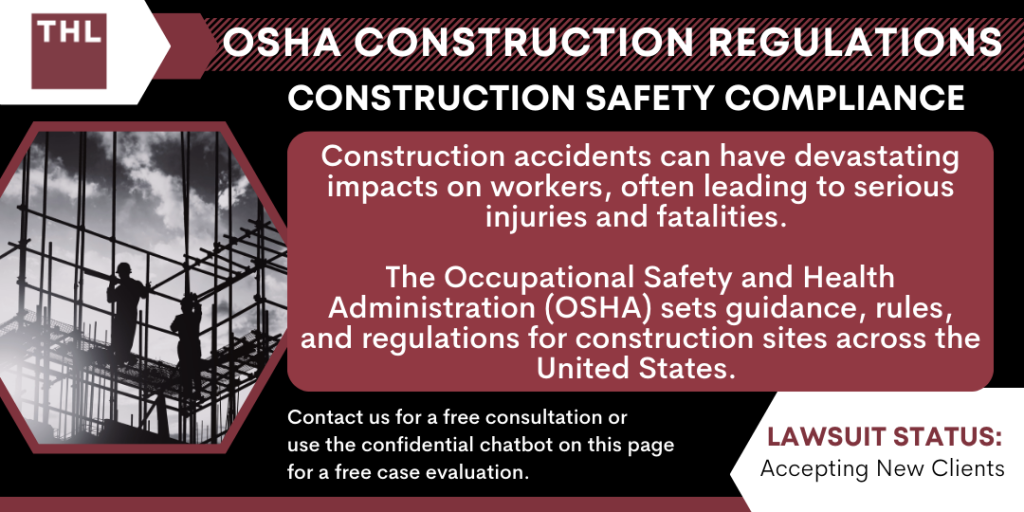
If you were involved in a construction accident and believe that a violation of OSHA construction regulations caused the incident, you may be entitled to compensation for your injuries.
Contact TorHoerman Law for a free consultation.
You can also use the chatbot on this page to find out if you qualify for the construction accident lawsuit instantly.
General requirements under OSHA and other safety and health programs are written to protect workers and visitors to construction sites, and when these standards are violated, individuals can be put at risk.
Reach out to our construction accident legal team with any questions you may have about worker protections and regulations, lawsuits for construction injuries, and more.
We’re here to help you.
The most common OSHA violations in construction include lack of fall protection, improper use of ladders and scaffolding, inadequate hazard communication, and electrical safety hazards.
These violations often stem from neglecting OSHA’s safety standards and failing to provide adequate training to workers.
OSHA enforces safety regulations through regular inspections, responding to worker complaints, and investigating accidents.
Inspectors assess compliance with safety standards and can issue fines or orders for corrective action if violations are found.
Penalties can range from minor fines for small violations to significant fines and litigation for severe or repeated violations.
In extreme cases, criminal charges may be filed, especially if negligence leads to serious injuries or fatalities.
Injured workers may be eligible to pursue compensation through Construction Accident Lawsuits.
Workers or concerned individuals can report safety violations anonymously to OSHA through its website, by phone, or by mail.
OSHA keeps the identity of the complainant confidential.
If a worker is injured due to negligence and/or violations of OSHA standards, they may be eligible to pursue legal action.
Reach out to an experienced Construction Injury Lawyer for a free consultation.
If a company is found in violation of OSHA standards following an accident, it faces legal consequences including fines, increased scrutiny in future inspections, and potential civil lawsuits from injured parties.
A construction worker injured due to an employer’s non-compliance can file a workers’ compensation claim or, in certain cases, a personal injury lawsuit.
Legal advice should be sought to explore the best course of action.
Contact TorHoerman Law for a free consultation with our construction accident lawyers.
You can also use the chatbot on this page to find out if you qualify for a Construction Accident Lawsuit instantly.
Congress established the Occupational Safety and Health Administration (OSHA) through the Occupational Safety and Health Act of 1970 as a response to the rising concerns about workplace safety.
The Occupational Safety and Health Act of 1970 was established to ensure safe and healthful working conditions for workers by setting and enforcing standards and providing training, outreach, education, and assistance.
Its importance lies in significantly reducing workplace hazards and implementing safety and health programs across various industries, thereby protecting the well-being and lives of employees.
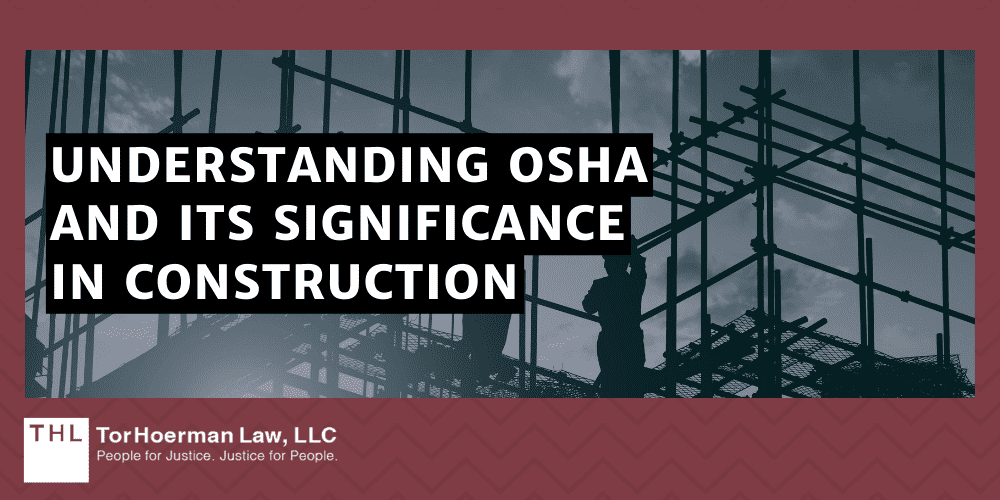
OSHA is responsible for regulating and enforcing safety and health standards in various industries and workplaces in the United States, including construction sites.
Construction companies must comply with OSHA regulations to protect employees from hazards and maintain a safe working environment.
It is essential to understand that OSHA’s role goes beyond just creating regulations.
OSHA conducts inspections to ensure compliance with safety standards and provides training and resources to help employers comply with the regulations.
OSHA also assists both employers and workers in understanding their rights and responsibilities to promote safer workplaces.
In the construction sector, where the potential for workplace hazards is inherently high, OSHA plays a crucial role in establishing and enforcing regulations to protect workers.
OSHA’s rules cover various aspects of construction work and address different types of hazards, including:
OSHA regulations not only define the standards for workplace safety but also serve as a comprehensive framework for preventing accidents, injuries, and fatalities.
Adherence to OSHA standards is not just a legal requirement but a moral imperative, ensuring the well-being of those who contribute to the growth of the construction industry.
As stated in the General Duty Clause, employers have a legal obligation to provide a safe workplace free from serious recognized hazards.
OSHA also requires construction companies to have a written safety program, safety training for workers, and an accident prevention plan.
Failure to comply with these regulations may result in citations, fines, or legal action, which can significantly impact the financial stability and reputation of construction companies.
OSHA also conducts inspections of construction sites to ensure that employers are constantly providing a safe working environment and complying with the regulations.
These inspections can happen randomly, in response to complaints, or following an accident.
OSHA inspectors have the authority to issue citations and penalties for violations and to require employers to take corrective action.
In addition to regulating and enforcing safety standards, OSHA provides worker rights and protections.
This system helps maintain accountability and encourages employers to prioritize workplace safety.
It also gives employees the power to take action and protect themselves from dangerous working conditions.
Some of the rights and protections that OSHA provides for construction workers include:
OSHA regulations, codified under Title 29 of the Code of Federal Regulations (29 CFR), establish comprehensive guidelines and standards to ensure workplace health and safety across various industries.
Within 29 CFR, specific sections, such as Part 1926, are dedicated to addressing the unique hazards and safety requirements in the construction sector.
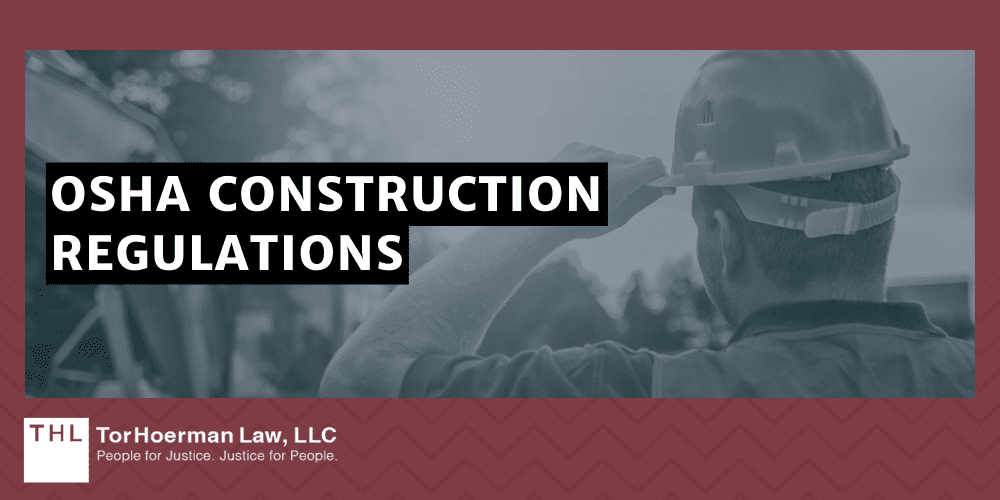
These construction-specific regulations cover a wide array of issues, from fall protection and scaffold safety to the handling of hazardous materials, ensuring that construction sites operate under stringent safety protocols to protect workers.
OSHA has developed a set of construction-specific regulations to address the hazards commonly found in the industry.
1926 Subpart C outlines the general safety and health provisions that apply to all construction activities.
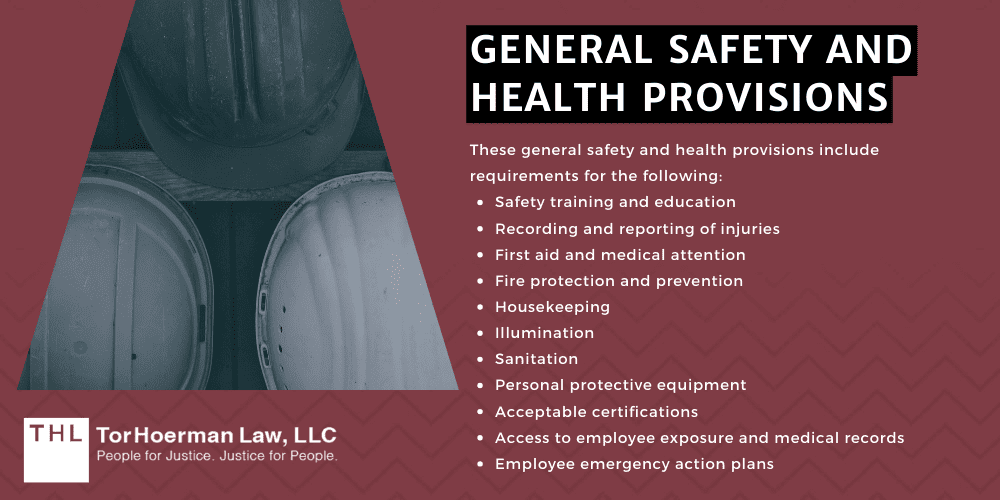
These general safety and health provisions include requirements for the following:
The emphasis on a safety program ensures that employers establish and maintain a safe working environment, reducing the risk of accidents.
1926 Subpart D focuses on occupational health and environmental controls.
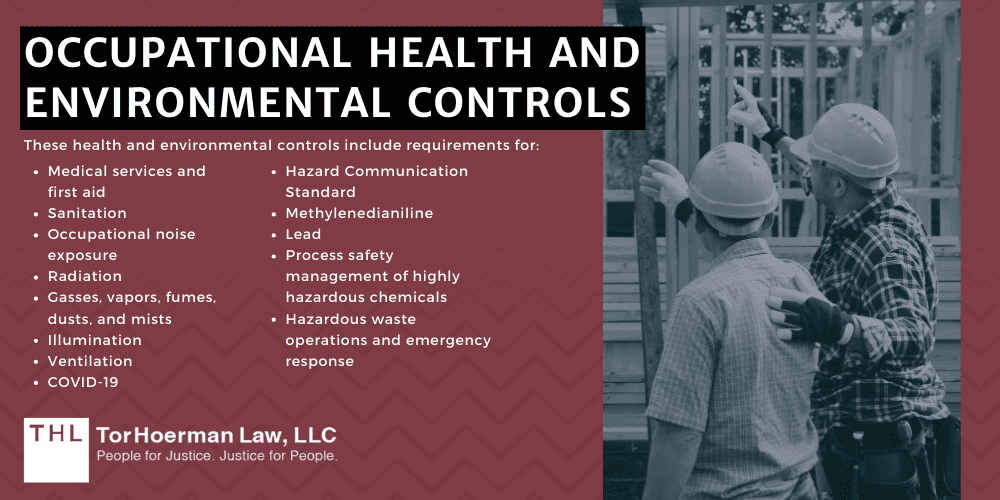
These health and environmental controls include requirements for:
This section establishes the need for employers to assess and control health hazards, provide PPE, and implement measures to reduce exposure to harmful substances, contributing to the overall well-being of workers.
1926 Subpart E mandates the use of personal protective equipment (PPE) to minimize exposure to hazards on construction sites.
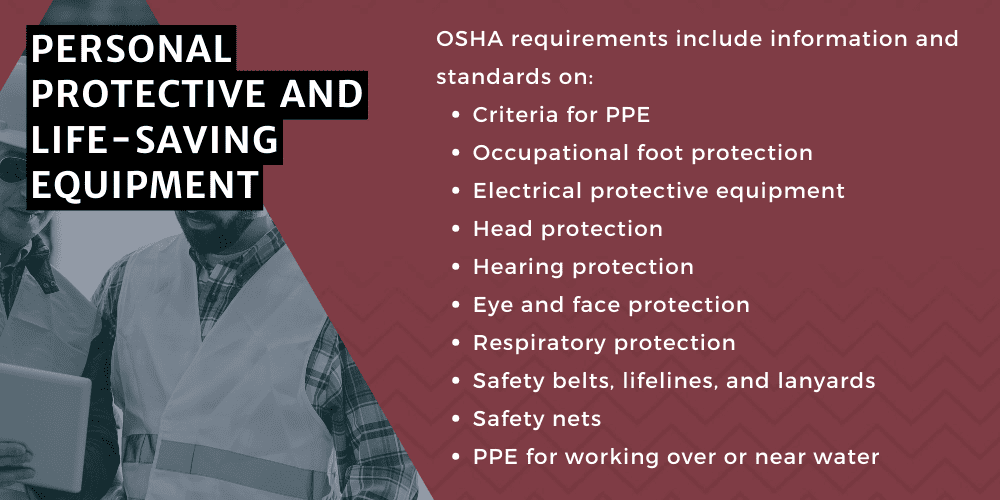
OSHA requirements include information and standards on:
PPE is a crucial aspect of workplace safety, and this regulation ensures that employers provide the necessary equipment to protect their workers from potential hazards.
Proper use of PPE significantly reduces the risk of injuries and enhances worker safety.
1926 Subpart F focuses on fire safety in construction by outlining requirements for fire prevention plans, fire protection equipment, and training.
The OSHA fire protection and prevention rules ensure that construction sites are equipped to prevent, detect, and control fires, reducing the potential for injuries and property damage.
It also promotes awareness of potential fire hazards, such as flammable liquids, liquified petroleum gasses, and temporary heating devices, and outlines the necessary precautions to minimize accidents and injuries.
Proper communication is vital on construction sites.
1926 Subpart G addresses using signs, tags, signals, and barricades to warn workers and the public about potential hazards.
This section promotes awareness of potential dangers and necessary precautions to avoid accidents.
Employers must train employees to recognize and understand the meaning of different signs, signals, and barricades.
Proper signage and communication minimize the risk of accidents, keeping everyone on the site safe.
1926 Subpart H establishes guidelines for the safe and proper handling, storage, and disposal of waste materials on construction sites.
This guidance helps prevent injuries related to lifting, handling, and storing materials, promoting a safer work environment.
Employers must ensure workers have the necessary training and equipment to handle materials safely.
Proper disposal of waste materials is also crucial in maintaining a safe and healthy work environment, reducing the risk of accidents and illnesses.
1926 Subpart I focuses on the safe use of tools in construction.
This section provides guidance on the use of the following tools on the job site:
OSHA sets requirements for tool selection, inspection, maintenance, and usage, minimizing the risk of injuries due to tool-related accidents.
Proper training and use of tools contribute to a safer work environment.
Welding and cutting are common activities in construction.
1926 Subpart J outlines safety requirements for these processes, including proper ventilation, fire prevention, and protective equipment, to reduce the risk of burns, fires, and other related accidents.
OSHA also addresses training and qualifications for welding and cutting operations, ensuring that workers are competent and equipped to perform the tasks safely.
Electrical parts are essential yet significantly hazardous in construction.
1926 Subpart K covers the safe use of electricity, including:
Adhering to these requirements helps prevent electrical shocks and fires on construction sites.
It also sets electrical equipment and installation standards, promoting a safer work environment.
Scaffold safety is critical in construction.
1926 Subpart L provides detailed requirements for the construction, use, and inspection of scaffolds.
These safety and health regulations also emphasize proper education and training on various types of scaffolding and aerial lifts and the risks associated with their usage.
Following correct scaffold practices reduces the risk of falls, collapses, and other scaffold-related accidents.
Fall protection is a primary concern in construction, and employers have a legal duty to provide measures to protect workers from falls.
1926 Subpart M outlines requirements for fall protection systems, including guardrails, safety nets, and personal fall arrest systems.
These safety regulations also addresses training and safety protocols, significantly reducing the risk of falls from heights.
1926 Subpart N addresses the safety requirements for using helicopters, hoists, elevators, and conveyors in construction.
This section of the OSHA regulations focuses on equipment safety, operator training, and preventive measures, reducing the risk of accidents involving these systems.
Proper maintenance and usage of these tools increase their lifespan and promote a safer work environment.
Some construction projects involve extensive digging and trenching, posing a significant risk to workers.
1926 Subpart P covers safety requirements for excavations, trenches, and protective systems.
This section highlights proper excavation planning and inspection to identify potential hazards and prevent cave-ins.
The standard also sets guidelines for providing safe access and egress in excavations, reducing the risk of accidents and injuries.
Concrete and masonry operations present specific hazards.
1926 Subpart Q addresses the safe construction and use of formwork, reinforcing steel, and other elements in concrete and masonry construction, reducing the risk of collapses and injuries.
The standard also sets requirements for proper equipment, training, and supervision to ensure safe operations on construction sites.
Steel erection involves unique risks, including falls and structural collapses.
1926 Subpart R outlines safety requirements for erecting structural steel, including fall protection, training, and proper connections, reducing the risk of accidents.
This section also sets standards for installing joists, beams, columns, and other components to ensure a secure structure.
1926 Subpart S focuses on workers’ safety in underground construction, caissons, cofferdams, and compressed air work.
These regulations address hazards such as engulfment, drowning, and decompression sickness, reducing the risk of accidents in these challenging environments.
The standard also sets requirements for air quality monitoring and emergency procedures to protect workers’ health and safety.
Demolition work poses unique risks due to the potential for structural failures and the release of hazardous materials.
1926 Subpart T establishes safety requirements for demolition operations, including:
The standard aims to prevent accidents, injuries, and fatalities during demolition work through proper planning, training, and appropriate methods and equipment.
1926 Subpart V focuses on workers’ safety in electric power transmission and distribution in construction.
These standards address electrical hazards, including line clearance, enclosed spaces, equipment and tools, protective measures, grounding, testing, and training, reducing the risk of electrical injuries.
The standard also sets guidelines for working near overhead lines and provides requirements for conducting emergency rescue operations.
Properly implementing these safety protocols reduces the risk of electrical accidents, burns, and fatalities on construction sites.
1926 Subpart W addresses using rollover protective structures (ROPS) and overhead protection on construction equipment.
These sections aim to prevent injuries caused by rollovers and falling objects, enhancing the overall safety of construction operations.
The standard sets requirements for the design, installation, and use of ROPS and overhead protection systems on various types of equipment, promoting a safer construction environment.
Stairways and ladders are common elements on construction sites, and their safe use is crucial.
1926 Subpart X provides requirements for the construction, service, and maintenance of stairs and ladders, reducing the risk of falls and injuries.
The regulation addresses critical topics such as proper ladder selection, placement, and secure anchoring to prevent accidents and protect workers’ safety.
Construction workers may encounter toxic and hazardous substances, such as asbestos, PCBs, and other industrial chemicals.
1926 Subpart Z establishes requirements for the protection of workers from exposure to such substances, including:
The standard sets requirements for exposure limits, monitoring, protective equipment, and medical surveillance to prevent adverse health effects on workers.
These safety regulations also require training and information exchange between employers and employees regarding hazardous substances on the construction site.
Proper implementation of these measures promotes a safe and healthy working environment.
Confined spaces present specific hazards, including poor ventilation and the potential for engulfment.
1926 Subpart AA outlines safety requirements for work in confined spaces, including atmospheric monitoring and emergency response procedures, reducing the risk of accidents in these environments.
The standard also sets training and communication requirements to ensure the safety of workers in confined spaces.
Cranes and derricks are common on construction sites, and their safe operation is critical.
1926 Subpart CC provides comprehensive safety requirements for cranes and derricks, including operator certification, inspection, and assembly/disassembly procedures, reducing the risk of accidents involving these lifting devices.
The regulation also addresses specific hazards, such as power line contact and crane tipping, ensuring the safety of workers and those in the vicinity.
OSHA sets standards to protect workers from accidents and injuries on the job site.
Unfortunately, some employers may neglect these safety requirements or fail to implement them properly.
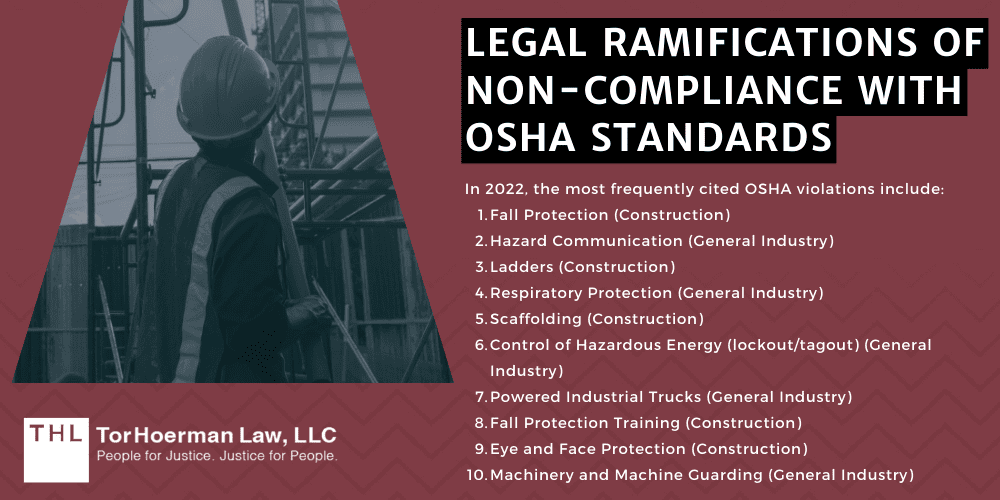
In 2022, the most frequently cited OSHA violations include:
Many of these violations involve the construction industry, demonstrating the importance of adequately implementing safety protocols.
In such cases, workers may suffer injuries or illnesses due to unsafe working conditions.
Failure to follow safety requirements can result in high employee turnover rates, increased workers’ compensation costs, and damage to a company’s reputation.
Employers may also face legal ramifications for non-compliance with OSHA standards, including fines and penalties.
In severe cases, injured workers may pursue criminal charges and potential lawsuits against their employers.
Non-compliance with OSHA standards can have severe legal consequences, leading to construction accident lawsuits.
When accidents occur due to safety violations, injured workers have the right to seek compensation for medical expenses, lost wages, and pain and suffering.
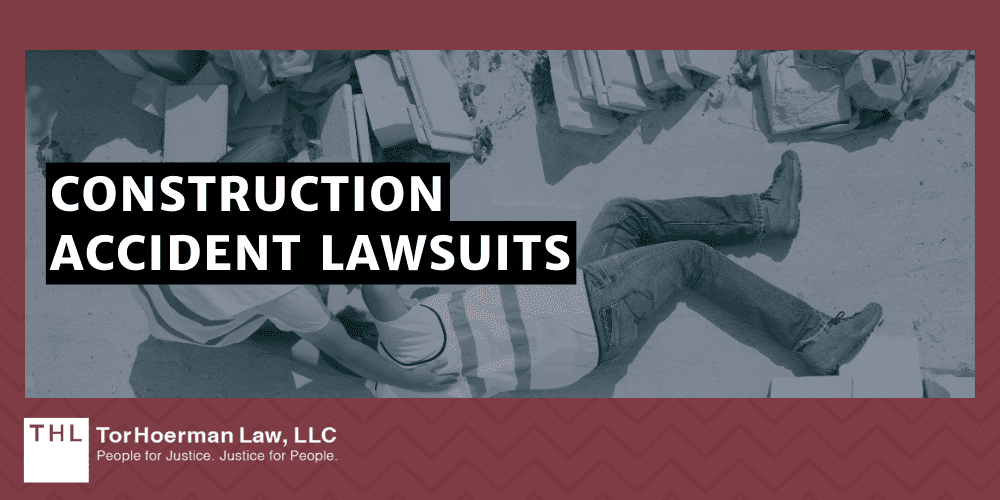
Construction accident lawsuits often hinge on demonstrating that the employer’s negligence, such as failing to adhere to OSHA standards, directly contributed to the incident.
In some cases, workers may also pursue legal action against third-party contractors or equipment manufacturers if their negligence also played a role in the accident.
A construction accident lawyer plays a crucial role in advocating for the injured worker’s rights in the aftermath of a construction accident.
These legal professionals specialize in navigating the complexities of construction accident cases, leveraging their understanding of OSHA standards to build a compelling case.
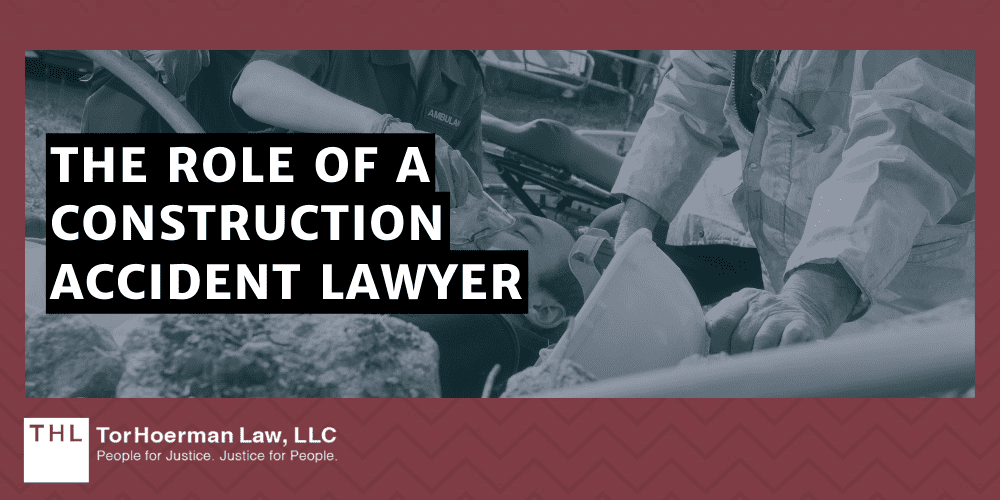
OSHA standards serve as a foundational element in construction accident lawsuits.
Construction accident lawyers use OSHA regulations to establish a clear standard of care that employers must uphold.
By demonstrating how employers violated safety regulations, these legal experts can help victims strengthen their claims, hold negligent parties accountable for their actions, and seek justice for their damages.
While OSHA regulations are enforceable by law, the commitment to safety compliance goes beyond mere legal requirements.
Construction professionals and employers have a moral obligation to prioritize the well-being of their workers.
Creating a culture of safety not only minimizes the risk of accidents but also fosters a work environment that values the lives and health of those contributing to the construction industry.
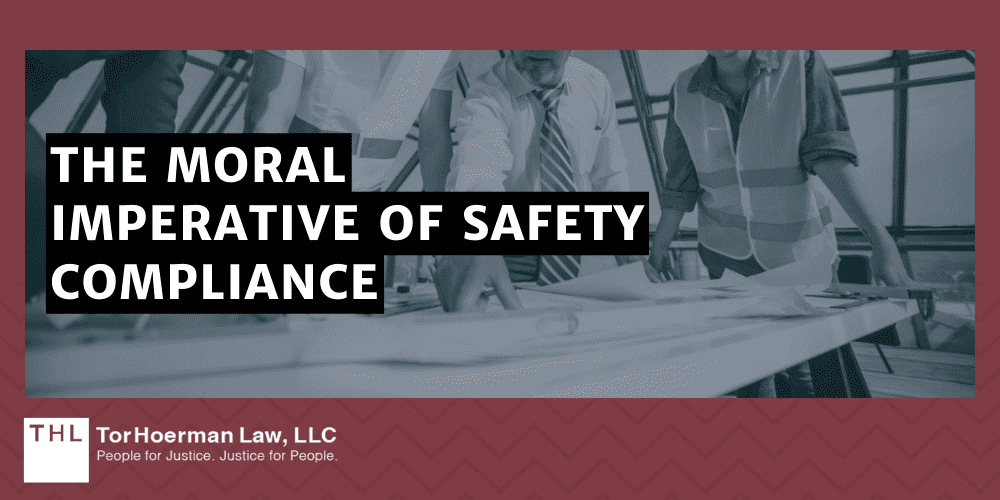
The true measure of success in construction goes beyond project completion — it includes ensuring that every worker returns home safely.
Safety compliance is a proactive approach to protecting workers and preventing accidents.
By investing in comprehensive training, implementing OSHA standards, and fostering a safety-first mentality, construction companies can contribute to a culture of well-being and accountability.
Construction is a fast-paced and high-stakes industry where safety is non-negotiable.
OSHA construction regulations are a comprehensive framework for ensuring workplace safety, covering everything from equipment operation to hazard communication.
The legal ramifications of non-compliance underscore the importance of adhering to these standards, not just to meet regulatory requirements but to protect the well-being of construction professionals.
Unfortunately, accidents can still occur despite strict safety protocols.
When you or a loved one suffers from injuries due to construction-related incidents, you have the right to hold negligent parties accountable and seek compensation for damages.
The experienced lawyers at TorHoerman Law understand the intricacies of construction accident cases, and we are committed to giving victims a strong voice in pursuing justice and securing the compensation they deserve.
Contact us today for a free consultation.
You can also use the chatbot on this page to find out if you qualify for the construction accident lawsuit instantly.

Owner & Attorney - TorHoerman Law
December 15, 2023
December 6, 2023
November 17, 2023

TorHoerman Law was responsible for handling a medical case for our family. I was extremely impressed with their professionalism and ability to react quickly. They also did a nice job keeping us updated with the case throughout the process. This was the first time experiencing a situation like this and Tor Hoerman law did an excellent job from start to finish.

TorHoerman Law is an extraordinary law firm – a firm that truly makes the client’s best interests the primary concern. Their team of personal injury lawyers are experienced, personable, and well versed in a range of litigation areas. They are supported by a dedicated team of staff that are as equally friendly and helpful. I would recommend TorHoerman Law for any personal injury litigation needs.

All of my questions were answered quickly and in a way I could understand. Steve and the entire staff were friendly and professional.

I highly recommend this law firm! The attorneys and staff at THL worked hard, communicated every step of the process, kept me well informed at all times, and exceeded all expectations! The staff is kind, considerate, professional, and very experienced. Look no further, call now!

Top-notch, hardworking attorneys!

A wonderful and professional legal team. They helped me when I needed expert legal representation! Thank you TorHoerman Law!

They contacted me the next day. Very nice people!

The firm went above and beyond. Thank you for everything.
We're ready to fight for you. We're ready to be your ally. And we're ready to start right now.
Dont' waste time, contact our law offices today.

Edwardsville, IL
Chicago, IL
St. Louis, MO